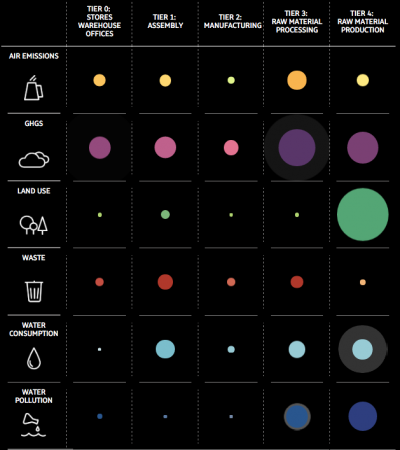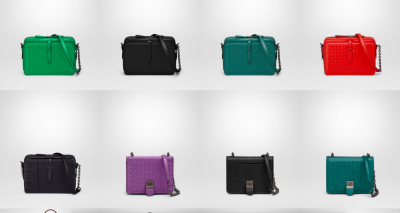 Merino sheep on the Australian grasslands
Merino sheep on the Australian grasslands
French luxury conglomerate Kering is helping the world visualize its environmental impact with an interactive environmental profit and loss statement.
Kering’s results page on the conglomerate's Web site contains a grid depicting the various steps in production and environmental categories in which it could make an impact, with each square containing a circle in relation to the impact that has been made. Kering’s transparency shows its dedication and the steps it has taken while also helping other companies to examine where they can make changes one step at a time.
“Businesses run on facts and figures,” said Marie-Claire Daveu, chief sustainability officer and head of international affairs at Kering. “Our environmental profit and loss account (E P&L) helps make environmental impacts understandable in business language (euros or dollars) and enables the possibility to compare between different types of impacts which before could not easily be compared, including impacts for products.
“It also helps facilitate comparisons between business units and investment decisions,” she said. “Simply put, it speaks the language of business.”
Putting a number on it
The different steps at which Kering can make a difference are store warehouse offices, assembly, manufacturing, raw material processing and raw material production. The impact on which is air emissions pollution, greenhouse gases and renewable energy, land use, waste, water consumption and water pollution.
The larger the circle in each box, the better Kering has done at making a positive difference. Circles considerably larger than others in the same category can be clicked on for an explanation and statistics of the difference.
Environmental impact grid
For example, the difference made in land use is generally quite small, except in raw material production, where a green circle fills most of its box.
Clicking will tell the user that Kering’s wool has 70 percent less environmental impact than conventional wool and his restored 7 million hectares of fragile ecosystems. Improving sheep grazing practices so grasslands could naturally restore and sourcing sustainable wool from select farms led to the improvement.
In another case study, Gucci began using cashmere and textile cuttings more efficiently to reduce the impact of animal rearing. As a result, only 2 percent of the group’s environmental impact is due to waste, and the brand’s regenerated cashmere does not require water or chemicals.
“These are all examples that help spur our imagination and stimulate our business,” Ms. Daveu said. “Through the E P&L we can now pinpoint our environmental impacts across the supply chain, and continue to develop appropriate sustainable sourcing programs and processing innovations to decrease and mitigate our footprint.”
The full E P&L, which translates environmental impact into financial gains or burdens, depicts the group’s progress and notes improvements in the group’s methodology. The statement’s formulas will be open-sourced, allowing other companies to monetize their effects on the climate.
Bottega Veneta leather innovations
As the statement shows, Kering is already beginning to see results in its bottom-line, stating, “our revenue growth has outstripped the growth of our impacts.”
Although leaders and decision makers would not necessarily doubt the significance of climate change, steps to combat it might be delayed because of financial worries; short-term benefits are easy to choose against drawbacks that seem to be in the distant future. Translating environmental impact into transparent financial terms may spur such thinkers to reconsider.
“Collaboration is a key element of sustainability,” Ms. Daveu said. “We believe that new ideas only benefit society when you can scale them.
"By open-sourcing the E P&L, we hope other organizations will join us in understanding their footprint and making more sustainable product decisions,” she said. “Furthermore, showing that the E P&L can be easily repeated year-to-year will advance efforts to build broader business engagement and the mainstreaming of corporate natural capital reporting.”
Bottega Veneta leather bags
The E P&L notes that next year’s will have more data and will include three-year trend information.
Leading by example, the statement also includes a section focusing on greenhouse gases and leather, walking through the actions Kering has taken and providing step-by-step guides for others to follow its example.
Dedicated to the cause
Kering has recently dedicated resources to informing the industry about the impact of climate change on apparel and accessories.
On average, the supply chain accounts for half of the typical corporation’s carbon emissions, according to a report by French luxury conglomerate Kering and non-profit consultancy BSR.
Climate change could have negative effects on the quality and availability of a number of raw materials, and the associated combative measures could also impact the fashion industry. To assure their own futures, brands in fashion must play a part in reducing emissions and combating climate change, building it into their long-term strategy (see story).
The conglomerate is continuing to take steps to raise awareness for this cause.
Kering is creating a conversation before December’s Sustainable Innovation Forum 2015 through a Twitter talk on environmental issues.
The #KeringLive event on Thursday, Nov. 19 at 10 a.m. EST will cover topics that specifically impact the fashion industry, allowing participants to discuss challenges and share best practices with their peers. This effort at opening a dialogue between members of the fashion industry follows the concept of Kering’s open-source report released earlier this year (see story).
“The deepening of the understanding in our business of how we rely on natural resources to make all our products has been important,” Ms. Daveu said. “Implementing supply-chain improvements take time, but already we have seen progress in several areas such as increased use of organic cotton for our luxury brands, increased use of recycled fibers and continued innovation in areas like heavy metal-free tanning.
“In addition, our purchases of ethical gold are coupled with continued work to gain greater traceability of diamonds and precious gems,” she said. “The Python Conservation Partnership and field projects we have ongoing for sustainable cashmere, silk and wool are examples of the work we are undertaking to sustain longer-term gains in reducing our footprint.
“For us at Kering, sustainability is truly inherent to the quality that defines luxury and we will continue to strive towards a more sustainable business model and leverage our learning from our annual E P&L results.”
Final Take
Forrest Cardamenis, editorial assistant on Luxury Daily, New York



